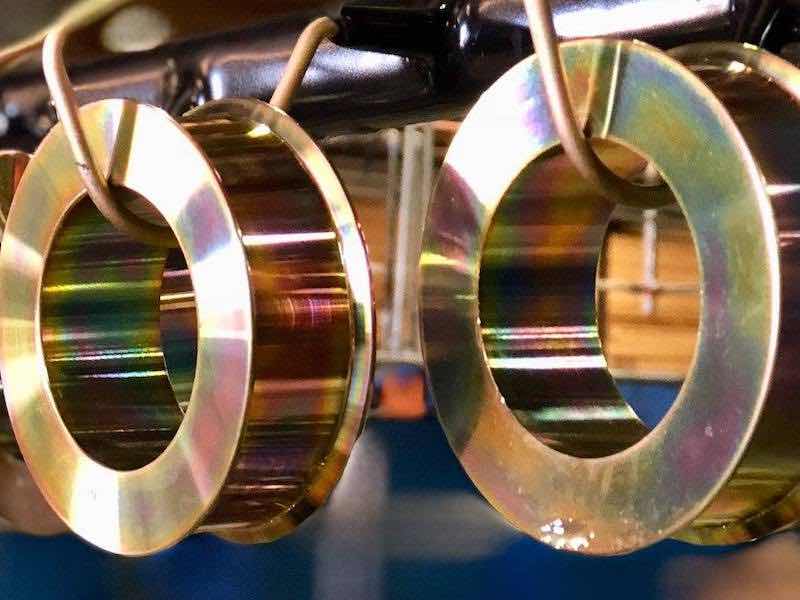The metal finishing industry is interesting and unique in many ways.
 Stephen RudyOne aspect is the valuable experience we gain through identifying problems, changes, modifications, and overall improvements that typically or unexpectedly occur. Many of us probably have a “card file” of these practical situations. Some events impact us in ways that help us tackle forthcoming situations. Recalling past troubleshooting work may help to run down future problems quicker or to eliminate repeat problems.
Stephen RudyOne aspect is the valuable experience we gain through identifying problems, changes, modifications, and overall improvements that typically or unexpectedly occur. Many of us probably have a “card file” of these practical situations. Some events impact us in ways that help us tackle forthcoming situations. Recalling past troubleshooting work may help to run down future problems quicker or to eliminate repeat problems.
In some instances, the culprit may have been obvious, overlooked, or required some in-depth detective work. The following situations are some of the varied surface preparation problems that I have experienced over the years. I focus on surface preparation, as this process, to me, is the most important first step to conditioning and processing parts.
Soak Cleaning
- A new bath makeup of the normally dependable cleaner was no longer removing the usually encountered oils and grease. This line had been shut down, and the soak and electrocleaner were both made up new. The problem was that the electrocleaner was used to make up both tanks. The all-important soak cleaner was left out.
- In another mix-up, the newly made-up electrocleaner did not provide the usual conductivity to support the required voltage. In fact, some steel parts were etching and forming brown spots (a sign of insufficient reserve caustic). Checking the maintenance log, it was confirmed the soak cleaner was inadvertently used to make up the new electrocleaner solution.
These examples highlight the need for careful observation to select the correct chemical product, in this case, cleaner. The finisher could add their own label to properly identify which tank said product is intended for. Or, the cleaner supplier may, upon testing, may provide a combination soak and electrocleaner as one product.
- A metal stamper routinely contracted a plater to process its parts. Suddenly the plater’s soak cleaner could not clean the oils off the received parts. Dumping the cleaner, rinses, and acid did not correct the problem. Since nothing in the plater’s operation had changed, he turned to the stamper for assistance. By conducting a check, the stamper’s purchasing department had switched from the usual water-soluble oil to chlorinated paraffin. The problem was easily corrected by returning to the water-soluble oil. The plater’s caustic-based cleaner reacted with the chlorinated paraffin, causing it to gel on the surface instead of removing it.
- During the workday the nickel-plated finish took on a more distinct haze as the workday progressed. The nickel bath was analyzed by wet chemistry and Hull cell and given a clean bill of health. Working up the line and monitoring cleaner bath temperatures, it was found that a solenoid valve controlling the steam inlet to the soak cleaner was sticking. The soak cleaner, usually at 145°F (63°C), was steadily heating up until a dry-on film did form on the parts at 190°F (88°C). This film would not come off in the other tanks and rinses that preceded the nickel bath.
- Nickel-plated brass screws were rejected due to insufficient plating in the threads. Inspecting the raw parts confirmed a copious loading of oil in the threads. The current soak cleaner was not removing the oil. Based on testing other candidates’ soak cleaners, a switch was made to a different blend that removed the oil, permitting nickel-plated coverage in the threaded areas.
- Steel parts were plated, revealing a sporadic, mottled, etched pattern. The cleaner was not removing grease. Passing down the process line on the parts, the grease coated localized spots, causing a “grease etch” in these small areas.
- Plated zinc die, castings were blistering. The blisters peeled right back off the base metal. Examination of the raw parts revealed pitted areas and cold shots. These surface defects were made worse by the caustic-containing soak cleaner etching the parts. This enlarged the pits. Progressing down the line, process solutions and rinses became trapped in these voids. The result was a gradual bleed out, resulting in plating blisters. Two corrections were made. The casting and buffing operations were improved to sufficiently seal the base metal surface. The soak cleaner was changed to a non-caustic blend. This eliminated chemical attacks on base metal that would result in the pitted surface condition.
- Aluminum parts were processed in a standard barrel acid tin plating cycle. Suddenly, a blistered plating deposit occurred that was easily corrected. In desperation to maintain a production output, all process tanks were replaced with new makeups, as were the rinses. Bear in mind this was a big undertaking, as aluminum parts were being processed. Ultimately the problem was found to be in the raw incoming aluminum coils from a new supplier. The coils were now being received with waxed protective sheets wrapped around each wound coil. These coils were stored outside in the sun, causing the wax to soften. Inside the building, the wax hardened up, forming a tenacious film on the aluminum that was not being removed in the surface preparation cycle.
Electrocleaning
- Barrel-plated parts were exhibiting corrosive pits. By carefully following the progression of tanks, it was found that residual hydrochloric acid was dragging into the electro cleaner (soak — rinse — acid — rinse — electroclean — rinse — acid). In the electrocleaner, chloride was oxidizing as chlorine gas bubbles on the surface of the anodically charged parts, forming the corrosive pits. The problem was solved by improving the quality of rinsing and switching to an electrocleaner especially inhibited to prevent this type of corrosive pitting.
- Rack-processed parts in a double cleaning cycle were found to have the same corrosive pits as in the previous barrel line problem. It was the same chloride contamination problem. But it was only occurring in the second electrocleaner, following the first hydrochloric acid, in a double cleaning cycle. This was confirmed by titrating for chloride in each cleaner.
- Nickel and chromium-plated parts exhibited periodic blistering. The ongoing problem was traced to the electrocleaner. With every pass of the racks, chromium was anodically stripped off the racks in the electrocleaner. The buildup of hexavalent chromium was passivating the steel. This coincided with the electrocleaner solution color progressively turning more yellow and losing its foaming characteristics. The addition of a proprietary reducing agent corrected the problem without having to prematurely dump the electrocleaner. Hexavalent chromium was chemically reduced to its trivalent state, forming insoluble chromium (III) hydroxide precipitate. Two visual observations: Cr+6 contamination forms a yellow color which also binds surfactants meant for cleaning the parts. Adding the reducing agent (typically a complex sugar) will, over a short period, eliminate the yellow solution color in favor of the original with perhaps a green tint and restore foaming characteristics. It is also good practice to add an electrocleaner with the chrome-reducing agent blended in the formula.
- Zinc die castings exited the electrocleaner with white corrosive patches. The wrong electrocleaner formulation was used. Switching to a moderate caustic blend fortified with silicate buffer eliminated the problem.
- Brass parts were dezincified, resulting in pink patches. Changing to a properly formulated electrocleaner for brass eliminated this problem. Nonferrous metals, such as brass and zinc, require electrocleaning formulations specifically buffered to inhibit attack on the surface in conjunction with a moderate, approx. 20% caustic soda concentrate blend.
- During a maintenance shutdown, the electrocleaner tank was thoroughly serviced. Upon startup, the solution seemed to age rapidly, as per unusual smut development on the parts. After running for a while, it was found that the cleaner had to be dumped. Someone noticed the bussing had been reversed during maintenance. The problem was plating a metallic smut film on the parts that were now negatively charged.
Acid Activation
- Nickel-plated wire goods were being reprocessed due to nickel-plating rejects. The parts were cycled around the machine a second time. A cathodic acid would be followed by an immersion acid, and parts would be typically re-nickel plated. This time, the new deposit peeled badly. During reprocessing, someone forgot to strip the post-nickel lacquer coating. Once this step was incorporated, the nickel replates were fine.
- The hydrochloric acid solution was economical but just could not provide a reasonable bath service life. Post-plate haze and blisters were traced back to the acid. Continued dipping of copper hooks and copper flight bars in the acid gradually increased the copper concentration, resulting in an immersion of copper on the steel parts. This was eliminated by adding an inhibitor to the acid to prevent the immersion copper problem.
- Alkaline zinc-plated stainless steel wire parts exhibited dullness and patches of blisters. The surface preparation cycle consisted of double cleaning, Woods strike, and alkaline zinc. The basis metal had surface cracks from the extrusion process. Hydrochloric acid penetrated these fissures and cracks, raising smuts. Changing to a sulfuric acid containing fluoride acid reduced base metal attack and minimized smutting. This eliminated the plating problem.
- Zinc die-cast parts were smutty after an acid dip. The result was a hazy and somewhat rough copper deposit. The 1% sulfuric acid dip was replaced with a proprietary sulfamic acid and fluoride solution, which left the parts smut-free. This corrected the copper deposit.
- One set of brass stampings nickel plated fine. Another set is plated with nickel blisters. The assay of basis metal confirmed 0.25% lead in the alloy of the easy-to-plate parts. The blistered parts contained 3% lead. The hydrochloric acid dip was changed to a sulfuric acid and fluoride solution. The fluoride, in particular, was required to dissolve the lead smut. Follow-up nickel plating was equally good for both sets of alloy brass parts.
- Series 380 aluminum castings were routinely desmutted with good success in a universal tri-acid, consisting of 50% nitric acid, 25% sulfuric acid, 25% water, and 8 oz/gal ammonium bifluoride. The fabricator switched to series 413 castings. This resulted in plating blisters. The concentration of ammonium bifluoride was doubled to correct this problem. Series 380 contains 7% to 9% silicon, whereas series 413 contains 11% to 13% silicon.
Stephen F. Rudy, CEF, is president of Chem Analytic and has written extensively about the finishing industry. Visit www.chemanalytic.com or call him at 917-604-5001.



































